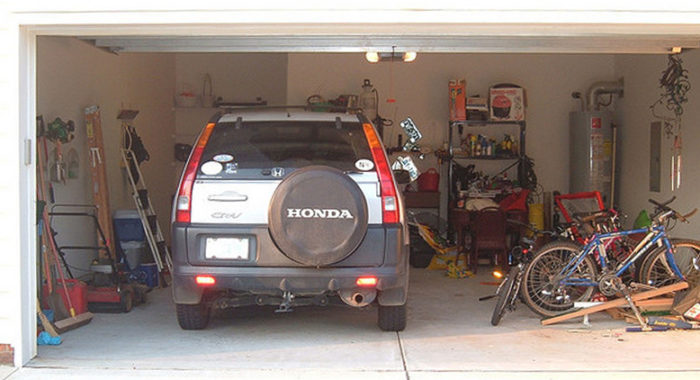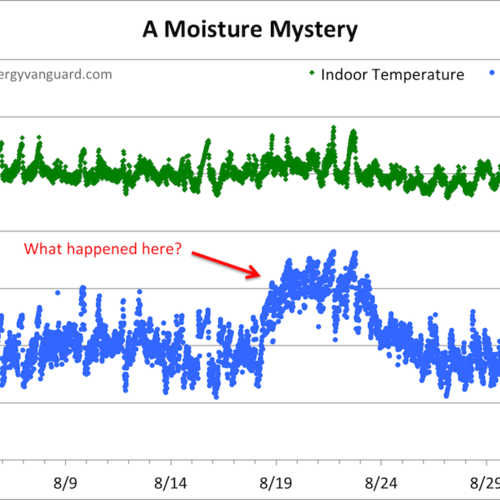
Image Credit: Rubbermaid Products
The odds are high that the indoor air quality is worse in a home with an attached garage than in a home without one. Just take a look at the photo here to see some of the potential sources of pollutants that can get into your home’s air. How many do you see?
Even without zooming in, I can spot five potential significant sources. The car is the biggest, of course. Every time it drives in or out, exhaust, including carbon monoxide, from the tailpipe enters the garage. On the left you can see a lawn mower and next to it a gasoline container. In the back is a gas water heater (in this case a direct vent type, which is a safer model than the standard natural draft type). To the left of the water heater are shelves full of various things, which may well include pesticides, fertilizers, and other stuff that fills the garage air with things you don’t want to breathe.
Isolating the garage
So the typical garage has a lot of bad stuff in it. You may not notice the smell in your own garage because you grow used to it after a while, but I often notice a toxic odor in garages. What can you do to keep that stuff out of the air in your home? The first step, of course, is to isolate the garage from the house as well as possible. Here are the first steps to keeping the garage air out of the house:
Ventilating the garage
There’s another thing you can do to keep that garage out of the house, too. Ventilate! With an exhaust fan in the garage, you can do two things to improve your indoor air quality. First, when the fan runs, it removes pollutants from the garage air and sends them outdoors.
Second, the exhaust fan puts the garage under a negative pressure. That way, when you open the door between the garage and the house, air is more likely to flow from the house to the garage rather than from the garage to the house.
Controlling the garage ventilation
You’ve got a few options here. You could set it up to run continuously, of course. If you’ve got a lot of nasty, off-gassing stuff out there and you really don’t want to get rid of it… well, my question to you is, why the heck don’t you just get rid of it? Build a shed out back. If you’ve already got a shed that’s stuffed to the gills, you could do like Arthur “Two Sheds” Jackson and think of getting a second one.
Rather than running the garage exhaust fan continuously, you could install a switch in the garage and control it manually. That’s not a great solution, though, because it often won’t be running at the time you need it to run. Say you drive into the garage, and the overhead door closes behind you. You’ve trapped some pollutants in the air but you have to get out of the car and turn the fan on before it starts removing them.
The best solution, in my opinion, is to use a controller like AirCycler’s GarageVent. When you install it, sensors wired into the doors will turn the exhaust fan on whenever a door to the garage is opened. Then the fan runs for a set amount of time (0 to 2 hours) after you close the door. You can also set it to run based on temperature.
And how much should you ventilate? Great question. I just found out at the ASHRAE 62.2 meeting this week that they’re doing a research project on garage ventilation. These aren’t official results yet, but what they said is that 50 cfm is probably too low and 200 cfm has worked every time. Stay tuned for the final results on that study, but I think 200 cfm is about the right number.
Complicating factors
Having said all that, installing a garage exhaust fan may or may not solve your problems. Here are some things that might negate or reduce the effectiveness of your fan, or even cause more problems.
- Natural draft water heater in the garage. These things can backdraft easily so if you install a large enough exhaust fan, you may end up putting more carbon monoxide into your garage, which could stick around after the fan goes off.
- Heating and air conditioning system in the garage. It’s not allowed by code anymore, but you could have this setup if you live in an older house. It’s possible that the HVAC system could be sucking up more air than your exhaust fan and sending a lot of contaminants right into your home.
- Heating and air conditioning vents in the garage. See my previous article on this topic.
- Negative pressure in the house. Some HVAC systems have unbalanced duct leakage that leads to negative pressure in the house. Some homes have really big exhaust fans. There could be a lot of stack effect. A number of causes could result in the house pressure being more negative than the garage. The garage exhaust fan does help reduce the pressure difference, but the end result may be more contaminants inside the home.
As always, the devil’s in the details, so make sure you either understand what’s going on and can measure the effect of a garage exhaust fan or you hire a pro who does and can.
Now, where do you think you’ll put that second shed?
Allison Bailes of Decatur, Georgia, is a speaker, writer, energy consultant, RESNET-certified trainer, and the author of the Energy Vanguard Blog. Check out his in-depth course, Mastering Building Science at Heatspring Learning Institute, and follow him on Twitter at @EnergyVanguard.
Weekly Newsletter
Get building science and energy efficiency advice, plus special offers, in your inbox.















One Comment
What type of fan do you recommend with the AirCycler? A normal bath fan with a damper? Most of the ones labeled as garage fans seem much too high cfm and don't have dampers.
Log in or create an account to post a comment.
Sign up Log in